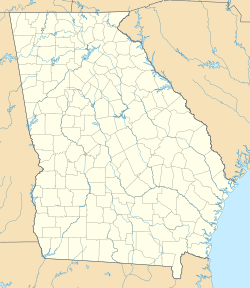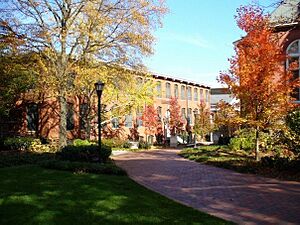Georgia Institute of Technology Historic District facts for kids
Quick facts for kids |
|
|
Georgia Institute of Technology Historic District
|
|
| Location | 225 North Avenue, Atlanta, Georgia |
|---|---|
| Area | 9 acres (0.036 km2), 12 buildings |
| Built | 1888 |
| Architect | Multiple |
| Architectural style | Beaux Arts, Colonial Revival, Romanesque |
| NRHP reference No. | 78000983 |
| Added to NRHP | October 25, 1978 |
The Historic District of the Georgia Institute of Technology is a special old part of the Georgia Tech campus. It's also called the Old Campus of Georgia Tech or the Hill District. This area is important for its cool buildings, how it helped with education, and its role in engineering and science. It's a Registered Historic Place. You can find it in Midtown Atlanta, Georgia, United States. It's near North Avenue to the south, Bobby Dodd Stadium to the east, Bobby Dodd Way to the north, and Cherry Street to the west.
Contents
Exploring the Old Campus
The Georgia Tech Historic District sits on "The Hill." This is the highest spot on the school's first nine-acre campus. It has 12 buildings that are a mix of old classrooms, dorms, and offices. They are all made of brick.
Some of the buildings you'll find here include:
- The Carnegie Building: This was the campus library until 1953. Now, it's where the Georgia Tech President's Office is located.
- Lyman Hall Laboratory: Named after Lyman Hall, an early president of Georgia Tech. This was the school's first Chemistry Building.
- The YMCA Building: John D. Rockefeller helped pay for this building in 1910. Today, it holds the Georgia Tech Alumni Association Offices.
These buildings are placed around the main Administration Building, also known as "Tech Tower." This creates unique spaces around campus. Old trees, over a hundred years old, shade the brick buildings. They make the area feel very special.
A brick road called Uncle Heinie Way goes around the Administration Building. It forms a loop. This road helps cars and service vehicles get to the buildings. There's also a newer area called Harrison Square, built in 1968. It has both brick and concrete paths, plus a green grassy space. This area was created after an old shop building was taken down.
Building Design and Planning
The Old Campus of Georgia Tech is special not just for its individual buildings. When it was first planned, people didn't think much about how the school would grow. Instead, they built what was needed right away. This practical way of building created a unique feel for the campus.
Most of these buildings were built between 1885 and 1923. This short time period helped them look good together. Even though they all have a similar style and were built in a consistent way, none of them look exactly alike.
A National Historic Place
In 1978, this area was added to the National Register of Historic Places. This means it's recognized as an important historical site. Near the entrance to Tech Tower, there's a historical marker. It tells about this special listing and the early history of the Georgia Tech campus. The Georgia Historical Society takes care of this marker.
The Twelve Historic Buildings
Here are the twelve main buildings that make up this historic district:
- Lettie Pate Whitehead Evans Administration Building (built in 1888)
- Clarence Knowles Dormitory (built between 1897 and 1992)
- Aaron S. French Building (built in 1898)
- Electrical (Engineering) Building (built in 1901), now called the Domenico Pietro Savant Building
- Janie Austell Swann Dormitories (built in 1901)
- Lyman Hall Laboratory of Chemistry (built in 1905)
- Andrew Carnegie Library Building (built in 1907)
- Joseph Brown Whitehead Memorial Hospital (built in 1911), renamed the Lloyd W. Chapin Building in 1987
- John Davison Rockefeller YMCA Building (built in 1912), renamed the Lawrence W. "Chip" Robert, Jr. Alumni/Faculty House in 1979
- David Melville Smith Building (built in 1923)
- William Henry Emerson Building (built in 1925)
- John Saylor Coon Building (five parts completed between 1911 and 1938)
There was also an "Old Shop" building. It was built in 1888 but burned down in 1892. A new one was built that same year. However, this second shop building was taken down in 1968.







